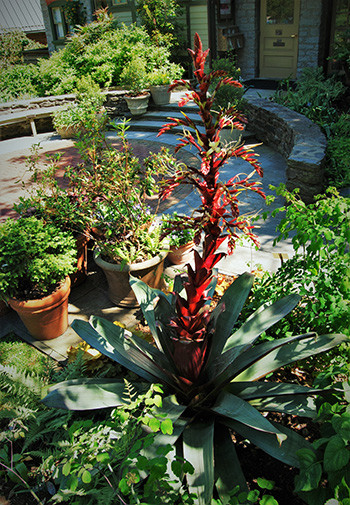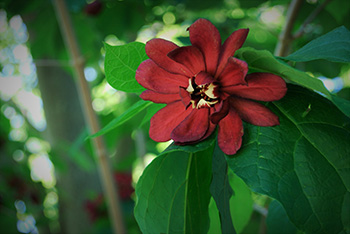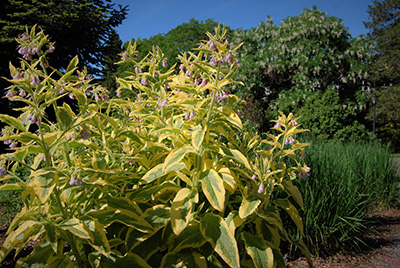
Plants of the Week: May 22
Alcantarea imperialis ‘Volcano Mist’
What a pleasure it is to be in the presence of such mighty elegance. Tucked seamlessly into the Scott Entrance Garden is a blooming Alcantarea imperialis ‘Volcano Mist’. These massive beauties can approach 8 feet in diameter and have up to a 3-foot tall flower stalk.
Alcantarea imperialis is part of a large family of tropical plants called Bromeliaceae, of which approximately one-third are endangered in the wild largely due to habitat loss and overharvesting for the retail market. Fortunately, some nurseries have started producing bromeliads from seeds or pups in an effort to save the family and bring it back from endangerment.
This particular A. imperialis was bought at the 2011 Unusual Tropical and Annual Sale and was later gifted back to the Arboretum after it grew too large for the owners to care for it properly. This past winter, the cup at the center of the plant, which typically holds water, was empty. Within a few days, the beginning of a flower spike was evident. The A. imperialis was planted in the Scott Entrance Garden in the early spring and will hopefully bloom for the rest of the summer.
Unfortunately, after the A. imperialis blooms,it will slowly start to die. The Scott Arboretum has taken steps by collecting pups from the blooming plant to continue this cultivar. In ten years time, there quite possibly will be another flowering bromeliad that was collected from this one, with just as much elegance and magnificence. Photo credit: R. Armstrong
Calycanthus floridus
Tucked in the back of a garden or planted front and center, this versatile shrub brings an array of visual splendor and diverse fragrances. Calycanthus floridus, commonly known as Carolina allspice, has a delightful strawberry-like scent to its burgundy flowers. These aromatic blossoms are scattered throughout the modest shrub at the end of its leafy branchlets, giving a peekaboo display. The mid-spring blooms are followed by brown pear-shaped seed capsules that have a spiced cinnamon scent when crushed. photo credit: R. Armstrong
Symphytum x uplandicum ‘Variegatum’
If there is one “super plant” to be had in your garden, it simply must be Symphytum. Highlighted here is a variegated Symphytum x uplandicum commonly known as Russian comfrey. With its brilliant yellow and green fuzzy leaves, light purple blooms, and clumping habits, S. x uplandicum ‘Variegatum’ brings wonderful body, color, and texture to a garden.
S. xuplandicum ‘Variegatum’ not only brings a pop of color to the garden, it also brings beneficial pollinators, such as bumblebees. It has been used as an herbal remedy since 400 B.C. in Greece, and it is still used today as a poultice to help stimulate cell growth and keep down inflamation. As if that weren’t enough, S. x uplandicum ‘Variegatum’ also serves as a fantastic mulch and compost addition. A group of S. x uplandicum ‘Variegatum’, as well as the non variegated variety, can be found in the John W. Nason Garden. Photo credit: R. Armstrong








No Comments